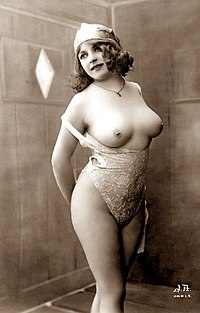Erotica

Erotica is (in a broad sense) any literary or artistic work that deals substantively with subject matter that is erotically stimulating or sexually arousing but (in a strict sense) is not generally considered to be pornographic. Erotic art may use any artistic form to depict erotic content, including painting, sculpture, drama, film or music. Erotic literature and erotic photography have become genres in their own right.
Curiosa is erotica and pornography as discrete, collectable items, usually in published or printed form. In the antiquarian book trade, pornographic works are often listed under "curiosa", "erotica" or "facetiae".[citation needed]
Erotica and pornography[]
A distinction is often made between erotica and pornography (and the lesser-known genre of sexual entertainment, ribaldry), although some viewers may not distinguish between them. A key distinction, some have argued, is that pornography's objective is the graphic depiction of sexually explicit scenes. At the same time, erotica "seeks to tell a story that involves sexual themes" that include a more plausible depiction of human sexuality than in pornography.[1] Additionally, works considered degrading or exploitative tend to be classified by those who see them as such, as "porn" rather than as "erotica" and consequently, pornography is often described as exploitative or degrading.[1][2] Many countries have laws banning or at least regulating what is considered pornographic material, a situation that generally does not apply to erotica.[citation needed]
For the anti-pornography activist Andrea Dworkin, "Erotica is simply high-class pornography; better produced, better conceived, better executed, better packaged, designed for a better class of consumer."[3] Feminist writer Gloria Steinem distinguishes erotica from pornography, writing: "Erotica is as different from pornography as love is from rape, as dignity is from humiliation, as partnership is from slavery, as pleasure is from pain." Steinem's argument hinges on the distinction between reciprocity versus domination, as she writes: "Blatant or subtle, pornography involves no equal power or mutuality. In fact, much of the tension and drama comes from the clear idea that one person is dominating the other."[4][5][6]
See also[]
- Eroticism
- Exploitation film#Sexploitation
- History of erotic depictions
- Lesbian erotica
- Lists of erotic films
- Love
- Monster erotica
- Sex in film
- Sex museum
- Shunga
- Tentacle erotica
- Women's erotica
References[]
- ^ Jump up to: a b "Erotica Is Not Pornography". William J. Gehrke. The Tech. December 10, 1996.
- ^ "Don't confuse erotica with porn". Jug Suraiya. The Times of India. August 15, 2004.
- ^ Dworkin, Andrea (1981). Pornography: Men Possessing Women. p. 39. ISBN 978-0-399-12619-2.
- ^ Steinem, Gloria (1984). Outrageous Acts and Everyday Rebellions (1 ed.). New York: Henry Holt & Co. p. 219.
- ^ "Erotica and Pornography: A Clear and Present Difference". Ms. November 1978. p. 53.
- ^ "Pornography—Not Sex but the Obscene Use of Power". Ms. August 1977. p. 43.
Further reading[]
| Wikimedia Commons has media related to Eroticism. |
- What Distinguishes Erotica from Pornography? - Leon F Seltzer, Psychology Today, 6 April 2011
- Erotica
- Genres
